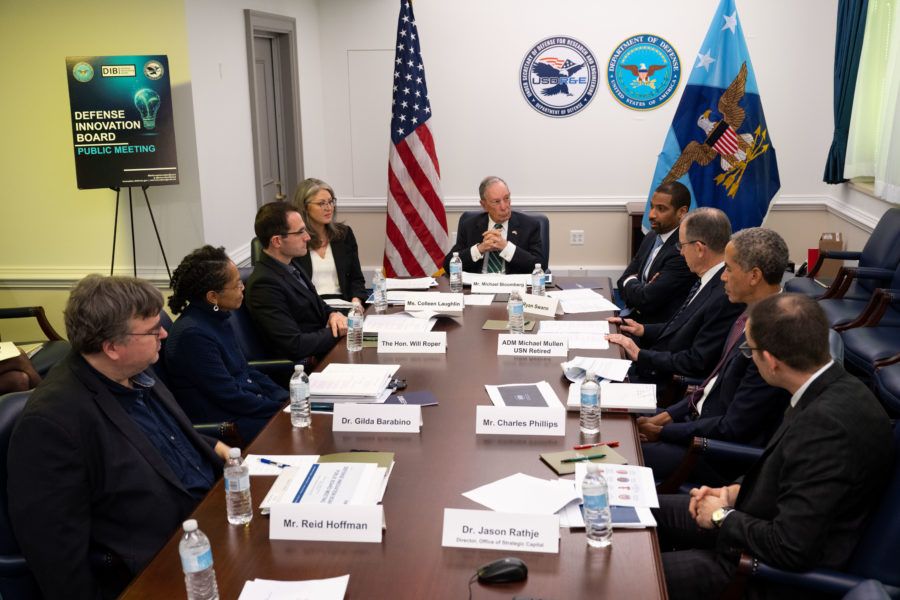As the Defense Department engages commercial entities to speed innovation, cultural and structural differences between government and the private sector continue to be the biggest hurdle to rapidly deploying new technology, the head of Air Force Futures told the influential Defense Innovation Board at a recent meeting.
“It’s not an access to innovation problem that we’re dealing with, it’s an innovation adoption problem,” said Air Force Lt. Gen. S. Clinton Hinote, deputy chief of staff for strategy, integration, and requirements, noting a number of barriers he’s experienced in recent years. “I’ve witnessed each of these [barriers] stifle innovation on behalf of the bureaucracy and at the expense of tomorrow’s warfighter.”
Hinote made his remarks at the end of a two-day meeting of the new Defense Innovation Board. Chaired by Michael Bloomberg, the nine-member board includes academics, technology professionals, and other experts who advise DOD on emerging technology and innovation and how to promote military technological dominance. Among its members are former assistant secretary of the Air Force Will Roper and retired Adm. Michael Mullen, former Chairman of the Joint Chiefs of Staff.
Passionate but positive, Hinote urged the board to identify incentives throughout the acquisition world that can speed technology development in a culture rife with bureaucratic roadblocks.
He said he’s witnessed leaders from three different administrations come in with a sense of urgency, only for that dynamic to not permeate through the bureaucracy. “Having the lack of sense of urgency in the middle is deadly, and that’s what it has been for us,” Hinote said.
One particular area Hinote focused on was risk timelines, noting that DOD’s actions are based on near-term risks, in contrast to its stated focus. Hinote also said there is a strong tendency to focus on “old ways” instead of new ones.
“There are a lot of soft vetoes in our department … and at any one point, there are so many different people, offices, interests that can block an action,” Hinote said. “They can’t start an action; they can’t initiate or get an action through, but they can block, and that’s a fact of life in this department that makes it very difficult to keep going.”
He added that there’s also a strong “not-invented-here culture,” where there can be competition between internal and external science and technology sectors. And while some competition between sectors can be good, Hinote added, it can be challenging when the timelines of a company differ from the government’s budget timelines.
It’s a particular issue with small startups whose fast-paced innovation might be perfect for DOD, but the startup must fund itself for multiple years until the budget process catches up with them. On top of that budget process, he added, is a lack of trust between the executive and legislative branches, particularly when looking at finding flexibility on how money is spent.
“At some point, we’re going to have to explore what types of transparency we need to get our congressional stakeholders semi-comfortable with the type of flexibility that we know we have to get to,” Hinote said. “And I think that involves a flexibility in intellectual property that we have not seen yet.”
In challenging the board to map out incentives, he emphasized the need to tap more into intellectual property and use it to scale.
For example, Hinote suggested that in critical times of need, if U.S. forces have good technology and an ally has good manufacturing capability, “it is in the national interest to release the intellectual property, give it to the partner and let them build the weapons, because at the moment, we are not able to build enough weapons fast enough,” he said.
Ultimately, Hinote said, the conversation must change, because oftentimes there’s little incentive to push technology boundaries, increase the speed of a bureaucratic process, or take risks.
“I don’t believe this is impossible; I don’t believe that people want to watch innovation flounder in our department,” he said. “But the incentives are structured in a way that makes it darn impossible, and until we call it out, I just don’t see how it gets better.”
In another brief to the board, Jason Rathje, director of the Office of Strategic Capital and co-founder and former director of AFWERX’s AFVentures division, insisted the government must do more to increase capital access for innovators.
With so many American companies investing and developing capabilities in science and technology, boosted by cooperation with academia, there has been world-class advancement in critical areas, Rathje said. But there needs to be a next step—to provide opportunities for entrepreneurs to have their technologies support national security goals.
Rathje added that OSC is looking at two new strategies to promote private investment as a national security tool: syndication and leverage.
“Syndication is a strategy that simply partners with private capital providers to co-invest in new technology efforts to help scale the business is we help scale the technology,” he said. “What leverage does is it lowers the cost of capital; private investors can make patient capital investments that are required, at the sizes that they’re required to invest, in deep technology companies.”
Rathje also celebrated the OSC’s partnership with the Small Business Administration and working with the Small Business Investment Company program. SBIC provides investment opportunities to technology companies in their early stages by leveraging the Federal Credit Program.
“The way these investment funds work is that we can license new limited partnerships that are vertically focused on deep technology areas,” he said. “We can provide two dollars of leverage, two dollars of debt, for every dollar of private capital that is raised.”
The SBIC initiative began in December, and Rathje said they hope to begin receiving applications for the initiative by mid-year. In addition, OCS will soon publish its inaugural investment strategy, which will review critical technology sectors and provide assessments regarding capital availability.
